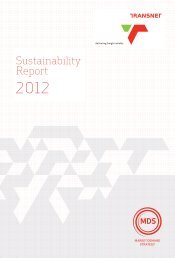Version1: Applicable from 1 April 2011 - Transnet
Version1: Applicable from 1 April 2011 - Transnet
Version1: Applicable from 1 April 2011 - Transnet
Create successful ePaper yourself
Turn your PDF publications into a flip-book with our unique Google optimized e-Paper software.
2.2.2. The CPO will determine the Terminal’s cargo working schedule and allocate windows<br />
on berths for the cargo working of nominated vessels in accordance with terminal<br />
capacity, nomination schedules and all relevant planning information as completed<br />
by the customer or representative in the TPT planning documents.<br />
2.2.3. The allocation of a berth is at the discretion of TPT and will be based on, inter alia,<br />
the availability of resources, cargo availability, terminal stacking space and cargo<br />
logistics factors, and not necessarily solely on the availability of a berth. For<br />
example, a vessel may be rescheduled to a later slot if the cargo is not available.<br />
2.2.4. If a planned vessel arrives in port and does not have at least 80% of its cargo in the<br />
terminal stack, and the balance available on road/rail inside the port, then the next<br />
arriving planned vessel may be berthed ahead of the senior vessel. (Refer to rules<br />
applying to cargo: Clause 2.9).<br />
2.2.5. A planned vessel which is not in possession of its ISPS clearance will forfeit its<br />
planned slot and will be re-scheduled at the discretion of TPT once such clearance is<br />
obtained.<br />
2.2.6. All vessels which are working cargo at any TPT berth shall have preference over “lay<br />
bye” or “bunker” ships i.e. those vessels berthed or seeking to berth for reasons<br />
other than cargo working. All requests for berths by such vessels must be directed to<br />
the TNPA Planning Official, who will in turn plan and confirm acceptance of such<br />
arrangements with the CPO of the respective terminal.<br />
2.3. Hatch and vessel preparedness<br />
2.3.1. Where it is a requirement for a nominated bulk vessel to present a hold cleanliness<br />
certificate before cargo working can commence, this requirement must be declared<br />
at the Phase II for planning purposes.<br />
2.3.2. Should it is not possible for a vessel to be surveyed before berthing due to it, for<br />
example not having hydraulic hatch covers, inclement weather or having to berth on<br />
arrival, the hold cleanliness certificate must be made available within the same two<br />
(2) hours as contemplated in clause 5.1.3 after berthing.<br />
2.3.3. A vessel, having been declared to have failed hatches, will only be re-scheduled by<br />
TPT <strong>from</strong> the date and time of presentation of the certificate declaring the hatches<br />
as passed.<br />
2.3.4. Vessels may not clean holds at working berths unless TPT in conjunction with the<br />
Port Environmental Officer and/or Marine Safety Officer has agreed thereto in<br />
writing. Where such an agreement is in place, no stand-by charges will apply<br />
provided that if, notwithstanding such agreement, resources have been booked in<br />
respect of the vessel, stand-by charges at the applicable rate will apply until such<br />
time as the vessel is ready to receive cargo.<br />
Terminal Operating Guidelines: Version 3 – <strong>Transnet</strong> Port Terminals Ro-Ro, Break-bulk, Bulk and Agricultural Terminals: 1 <strong>April</strong> 2013<br />
TRANSNET PORT TERMINALS, A DIVISION OF TRANSNET SOC Ltd 16

















